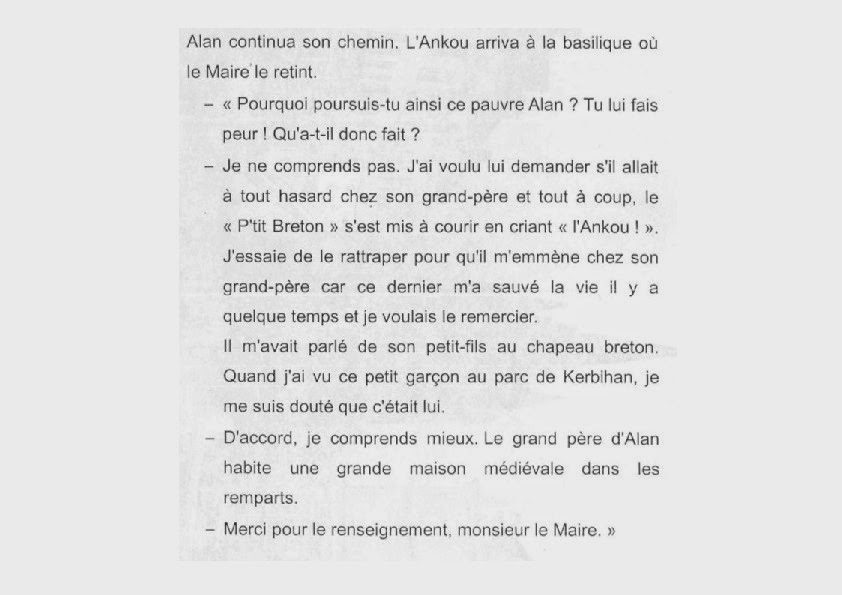Noël en France
Qui est le Père Noël ?
Who is Santa Claus ?
| Le père Noël est un gros bonhomme habillé d’un costume rouge à la fourrure blanche. Il habite au Pôle Nord. Il se déplace dans un traîneau tiré par 8 rennes, le premier étant le renne au nez rouge qui sert à guider le traineau. Dans la nuit du 24 au 25 décembre, le père Noël est très occupé. Il se pose sur le toit de toutes les maisons. Il prend des cadeaux dans sa hotte, son gros sac et descend par la cheminée. Il y dépose les cadeaux que les enfants les trouvent au matin lorsqu’ils se réveillent. | 
|
At night from 24 till 25 December, the Santa Claus is very busy. He arises on the roof of all the houses. He takes presents in his basket, his big bag and comes down by the fireplace. He deposits the presents there.
The children find them in the morning when they wake up.
Le sapin ...
The Christmas tree ...

| Depuis très longtemps, on utilise le sapin car il se conserve bien. Au Moyen-Age, on le décorait avec des pommes, pour rappeler l’arbre du Paradis. Ensuite les pommes sont été remplacées par des boules. On mettait également des bougies dans le sapin. Mais cela était un peu dangereux. Avec l’arrivée de l’électricité sont apparues les guirlandes électriques ; la première date de 1882. Les guirlandes électriques françaises sont colorées et clignotent souvent. Aujourd’hui, vous pouvez décorer votre maison avec un vrai sapin, acheté sur le marché, ou avec un sapin artificiel. Cela sent moins bon mais c’est plus facile à conserver! |
The French fairy lights are colored and often flash.
You can decorate your house with a real Christmas tree, bought on the market, or with an artificial tree. It smells less good but it is easier to preserve!
La crèche
The manger
| Il y a peu de famille en France qui ne mettent pas une crèche devant leur sapin. Cela n’est pas forcement lié à la religion mais c’est devenu une tradition comme une autre.
La crèche représente l’étable où Jésus est né. On y trouve donc les personnages de Joseph, Marie, l’enfant Jésus et quelques animaux, souvent un âne et un bœuf. Il y a des crèches plus complètes comprenant aussi les rois mages et d’autres personnes ou animaux. | 
|
There are few families in France who do not put a crib in front of their Christmas tree. This is not necessarily related to religion but it has become a tradition like any other. The crib is the stable where Jesus was born. There are therefore the characters of Joseph, Mary, baby Jesus and some animals, often a donkey and an ox. There are more complete nurseries also including the Magi and other people or animals.
Comment fête-t-on Noël en France?
How do we celebrate Christmas in France ?
Noël est à l’origine un fête chrétienne fêtant la naissance du Christ. Il y a toujours une Messe de Minuit le 24 Décembre.En France, Noël est une fête que l’on passe en famille.
Chaque maison est décorée par un sapin. On y accroche des guirlandes, des boules et d’autres décorations. Devant le sapin, on met une crèche où est illustré la naissance du Christ avec Joseph, Marie, l’enfant Jésus, un âne et un bœuf.
Le dîner de Noël est le 24 au soir. On y mange traditionnellement de la dinde avec des légumes. La bûche de Noël est toujours le dessert. Le soir, les enfants vont se coucher. Ce n’est que lorsqu’il sont endormis que le Père Noël vient déposer les cadeaux devant le sapin, en passant par la cheminée. Les enfants ne le voient donc pas. Au matin, dès qu’ils se réveillent, les enfants vont ouvrir leurs cadeaux. Ils passent la journée du 25 à jouer avec et à manger des crottes en chocolats.
Le 26 décembre n’est pas un jour férié en France.
Christmas is originally a Christian holiday celebrating the birth of Christ. There is always a Midnight Mass on December 24th. In France, Christmas is a celebration that is happening in families.
Each house is decorated with a Christmas tree. We hang on to it: garlands, balls and other decorations. In front of the tree, we put a crib where is shown the birth of Christ with Joseph, Mary, Baby Jesus, a donkey and an ox.
Christmas dinner is the 24th in the evening. Traditionally they eat turkey with vegetables. The Yule log is always dessert. In the evening, the children go to bed. It is only when asleep that Santa just drop the gifts to the tree, through the chimney. The children do not see it. In the morning, when they wake up, children will open their gifts. They spend the day of 25 to play with and eat poop chocolates.
December 26 is not a holiday in France.
Que mange-t-on à Noël ?
What do we eat at Christmas day ?


|
Le repas traditionnel français de Noël est une dinde. Elle est cuite au four, mangée chaude et accompagnée de légumes verts, pommes de terre ou autre.
Mais le met le plus important de Noël est le dessert : la bûche de Noël. Elle est au chocolat normalement, mais peut aussi être parfumé á la vanille, au caramel ou tout ce que l’on veut. On peut trouver des versions en gâteau et des version surgelées. Les français achètent leur bûche directement au pâtissier et il faut souvent la commander en avance. |
The traditional French Christmas meal is a turkey. It is baked, eaten hot, accompanied by green vegetables, potatoes or other.
But the most important sets of Christmas is the dessert: the Yule log.
Normally, it is chocolate, but can also be flavored with vanilla, caramel or whatever you want. One can find versions cake and frozen versions.
The French buy their log directly pastry and you often order in advance.


















































